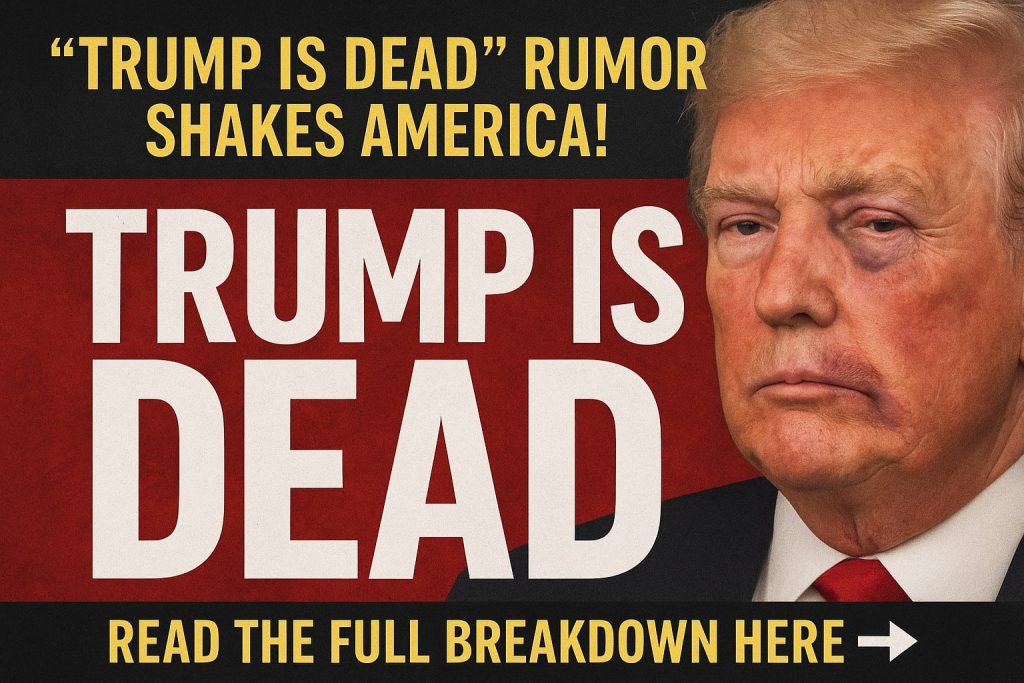
August 31, 2025 – Washington, D.C. – Social media exploded this week with a shocking rumor claiming “Trump is dead.” What began as scattered whispers online quickly snowballed into a full-blown media frenzy, trending across platforms like X (formerly Twitter), TikTok, and Facebook. Despite no credible confirmation, the rumor ignited a firestorm of speculation, memes, and conspiracy theories—showing once again how misinformation can spread faster than fact.
How Did the “Trump Is Dead” Rumor Start?
The speculation gained traction after President Donald Trump appeared in public with visible bruises and swelling on his face. Photos and videos from recent appearances raised questions about his health, with critics pointing to inconsistencies in official explanations. When the White House issued a vague statement about the marks being the result of “routine medical treatment,” many online users felt unconvinced.
From there, the phrase “Trump is dead” began trending. Within hours, millions of posts, shares, and memes circulated—ranging from mock funeral graphics to elaborate conspiracy threads about government cover-ups.
The Role of Social Media in Fueling the Rumor
Social platforms acted as an accelerant. On X, hashtags like #TrumpIsDead and #WhereIsTrump dominated trending lists. TikTok creators jumped in, posting videos with dramatic music, fake news headlines, and stitched reactions, further blurring the line between satire and “breaking news.”
Adding to the chaos was the so-called “Pentagon Pizza Report”—a viral conspiracy theory suggesting that a spike in late-night pizza deliveries near the Pentagon signaled “emergency meetings” about Trump’s health. While completely unverified, the bizarre theory went viral, symbolizing how online culture often blends humor with paranoia.
White House Response and Public Backlash
The White House attempted to calm speculation by dismissing the rumors, stating that Trump was “alive, well, and working.” Yet the response was criticized as “tone-deaf” and “non-transparent.” By not providing detailed medical records or clearer evidence, officials unintentionally fueled more doubt.
Political analysts warn that this lack of transparency could erode public trust, especially in an era where digital misinformation thrives. The episode highlights a delicate balance: protecting a president’s privacy while also ensuring the public’s right to know about their leader’s health.
Why People Believed the Rumor
Several factors made the “Trump is dead” claim believable to many:
- Visible Health Concerns – The unexplained bruising created suspicion.
- Past Secrecy – Trump’s history of withholding medical details reinforced distrust.
- Memes & Virality – Jokes and satire spread so widely they began to feel like facts.
- Polarized Politics – For both critics and supporters, extreme narratives find easy traction.
- Conspiracy Culture – Online communities thrive on filling information gaps with speculation.
Political and Cultural Impact
The rumor underscores a growing reality: viral narratives can shape political discourse even when false.
- For Trump supporters, the trend was seen as a cruel attack and a warning about media manipulation.
- For critics, it became a rallying cry about transparency and the need for clearer leadership communication.
- For the public at large, it raised alarms about how quickly false stories can dominate the national conversation.
Experts say such viral moments damage institutional trust, leaving citizens unsure of who or what to believe.
The Bigger Picture: Misinformation in U.S. Politics
This isn’t the first time viral rumors have hijacked the political spotlight. From the “Obama birther” conspiracy to false claims about election fraud, U.S. politics has repeatedly been shaped by misinformation. What makes the “Trump is dead” episode unique is how fast humor, conspiracy, and political tension merged into one viral storm.
Digital misinformation experts argue that platforms need stronger tools to prevent unverified claims from trending uncontrollably. Yet others warn that attempts to suppress viral content can backfire, reinforcing perceptions of censorship.
Final Take
The “Trump is dead” rumor wasn’t true—but its impact was real. It showcased how fragile public trust can be, how quickly misinformation spreads, and how deeply polarized the American political landscape remains. Whether seen as a meme, a conspiracy, or a political weapon, the frenzy reminds us that in today’s digital world, perception often travels faster than truth.



